 Sideway
BICK BLOG from Sideway
Sideway
BICK BLOG from Sideway
|
Link:http://output.to/sideway/default.asp?qno=130400011 Primality, Theorem of Wilson, Property of Giuga, Wolstenholme's Theorem, Prime Number, number theory PrimalityPrime numbers are natural numbers, e.g. 2, 3, 5, 7,..., which can only be divided by 1 and itself. Although the way to recognize the primality of a natural numbe is very simple, there is difficulty of distinguishing prime numbers from composite numbers when natural numbers become very large. The Theorem of Wilson (1770)[1]
The Theorem of Wilson is a corollary of Fermat's Little Theorem by Wilson in
1770, stated that If p is a prime, then
(p-1)!≡-1 (mod p) without a proof. Lagrange proves the theorem of Wilson
in 1773. Let the distinct residue set {1, 2,...,(p-2),(p-1)} of a number when
divided by a prime p. By polynomial expansion, let 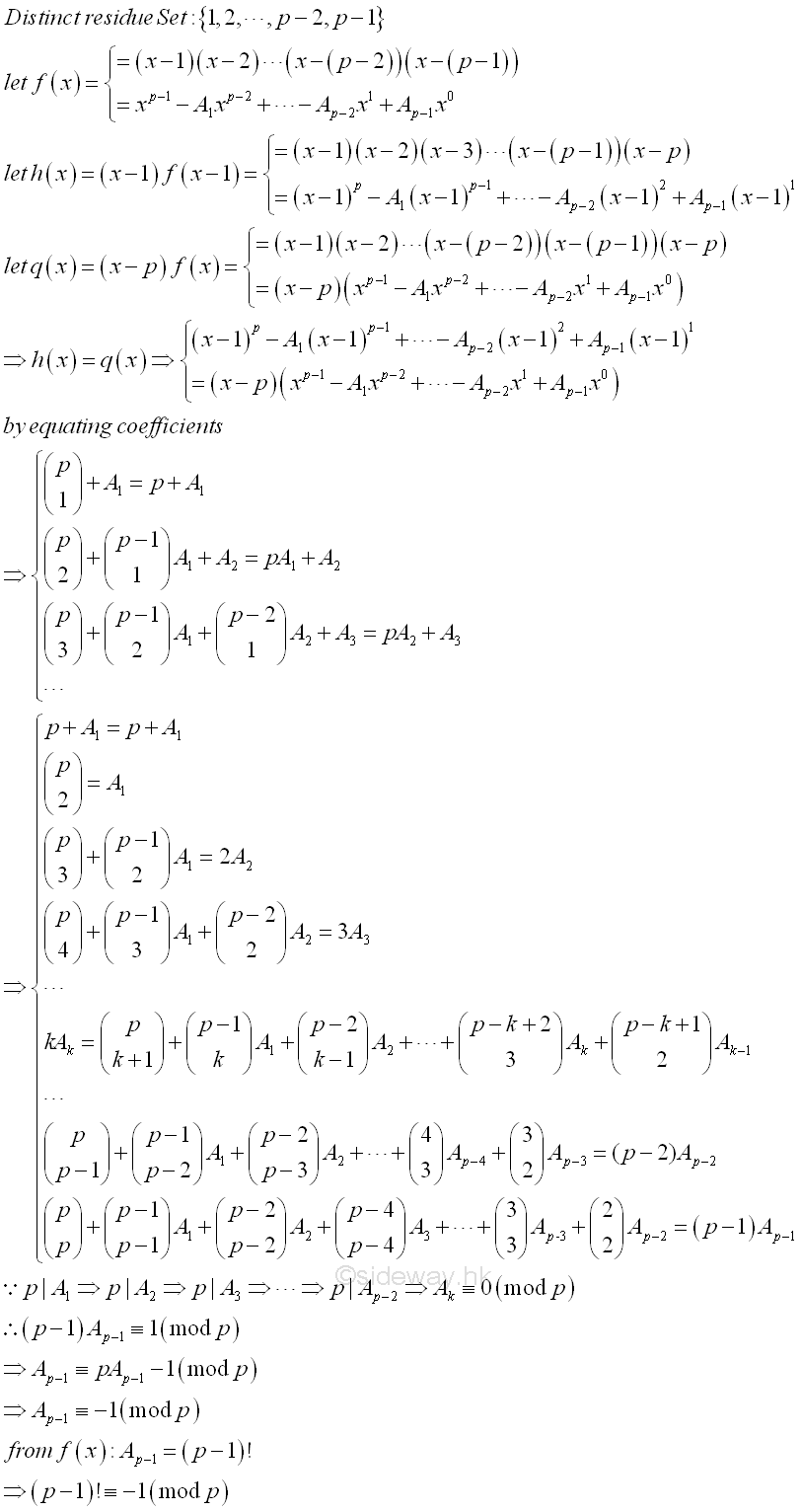
The theorem is also true for p=2. Since a composite number can be expressed as the multiplication of two numbers, so if p is a composite, it must be the product of two numbers smaller than p or (p-1)! must be the multiple of p. The theorem gives another important characterization of prime numbers and leds to the study of numbers of n!=1 and n!=1. However, this is not an effective method to test the primaity of a number because the calculation of p! involves log N steps. The Property of Giuga (1950)[1]From Fermat's Little theorem, jp-1≡1 (mod p) for j=1,2,3,...,p-2,p-1. The sum of these terms is equal to (p-1)≡-1 (mod p). Imply 
Giuga
interested in whether the converse is true or not. That is whether n is a prime
if n>1 and n divides 1n-1+2n-1+3n-1+...+(n-1)n-1+1. Or whether
there are composite numbers such that n=pq where p is prime and p divides 1n-1+2n-1+3n-1+...+(n-1)n-1+1. That is
Gp≡∑ n-1 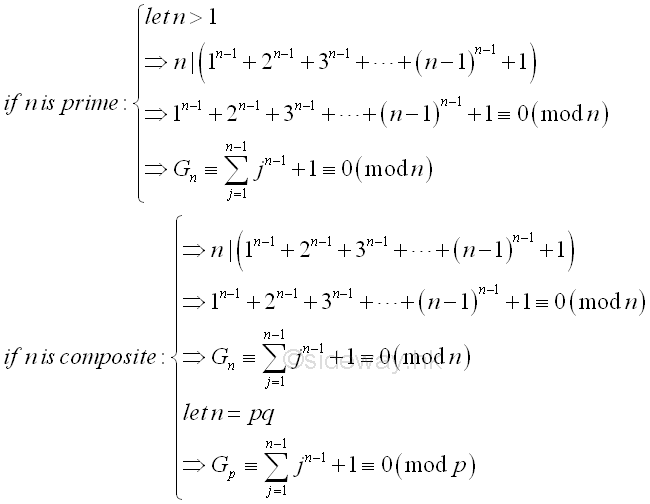
The counter example,
composite number, to the Giuga condition is
called a Giuga number. If n is a composite, let prime p divides n, then let
n=pq. Consider the counter example, the sum of the power t=n-1 of the set of
residue class when divided by prime p. That is S1≡∑ p-1 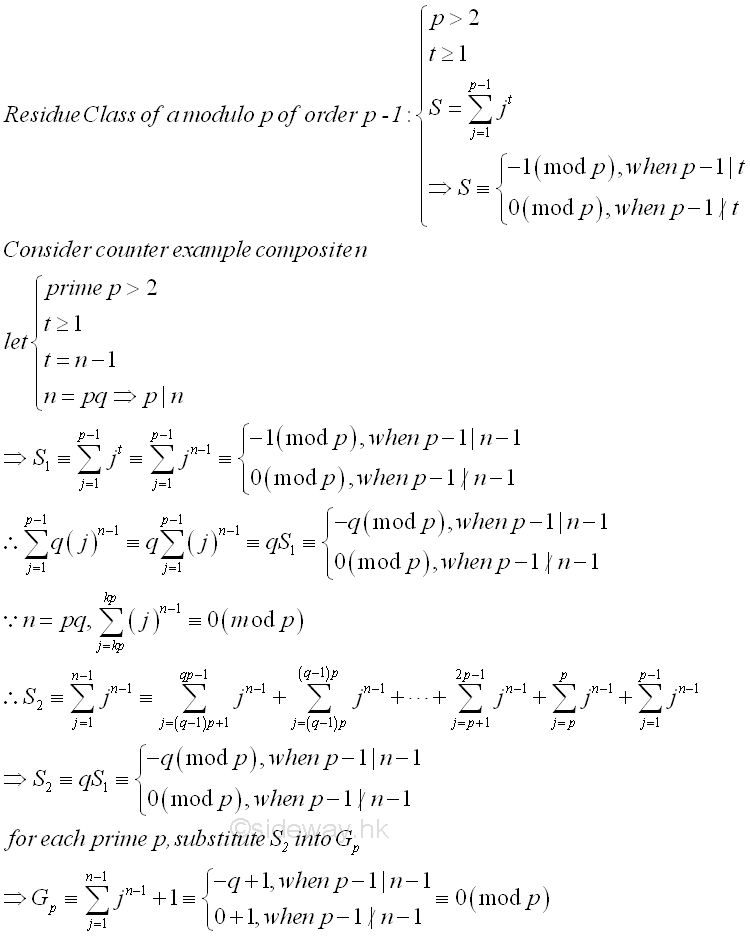
Thus if Gp≡0, then (p-1)|(n-1) where (n-1) is equal to pq-1=q(p-1)+(q-1), so (p-1) divides (q-1). From Gp, (-q+1)≡0 (mod p), imply q≡1 (mod p),then p divides (q-1) also. That is (p-1)|(q-1) and p|(q-1). Besides, since p|(q-1), imply p∤q, therefore n must be squarefree. Therefore with n is squarefree, (p-1)|(q-1) and p|(q-1), each of the distinct prime divisors p of n divides Gp , this is also true for n divides Gn. With (p-1)|(q=1) and p|(q-1), imply p2(q-1) divides pq-p or n-p. Since n≡pq≡p≡0 (mod p) and (p-1) divides (q-1), imply p|n and n≡pq-1≡q(p-1)+(q-1)≡p≡1 (mod p-1). 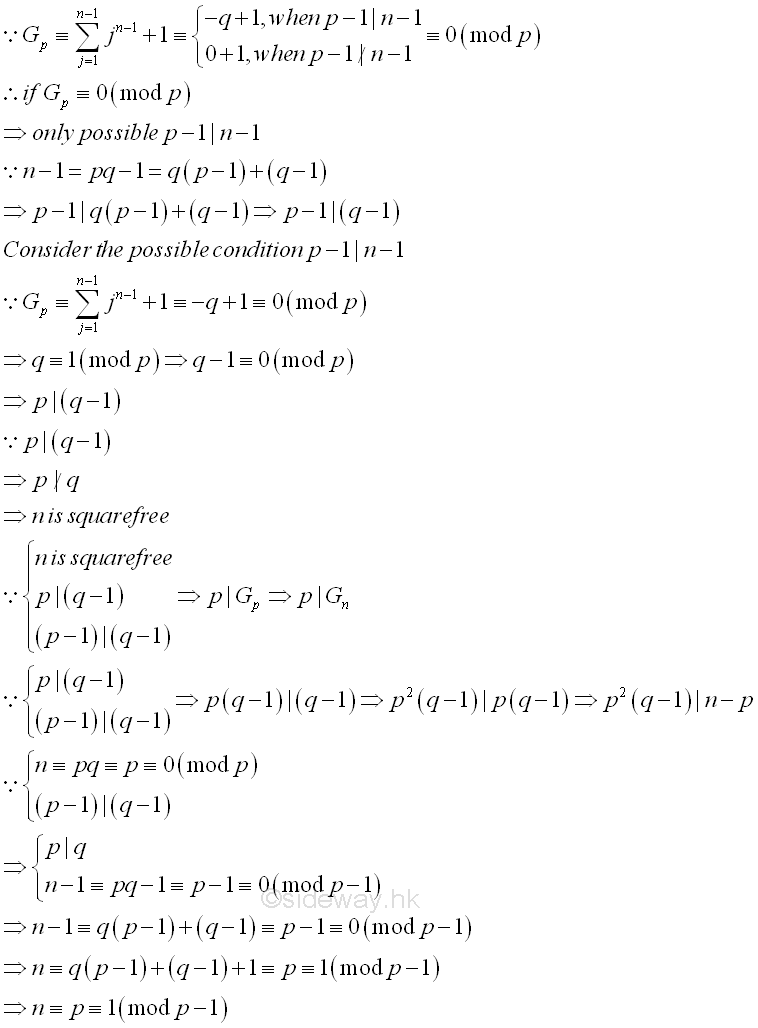
The Wolstenholme's Theorem (1862)[1]Another property of prime is from wolstenholme, proved in 1862 that if p is a prime greater or equal to 5 then p2 divides the numerator of 1+1⁄2+1⁄3+...+1⁄p-1 and p divides the numerator of 1+1⁄22+1⁄32+...+1⁄(p-1)2. And prime n greater than 3, n3 divides the combination of 2n-1 takes n-1 minus 1 Let H(p-1)= 1⁄1+1⁄2+1⁄3+...+1⁄p-2+1⁄p-1. By terms rearrangement, H(p-1)=(1⁄1+1⁄(p-1))+(1⁄2+1⁄(p-2))+...+(1⁄((p-1)/2)+1⁄(p-((p-1)/2))) = (((p-1)+1)⁄((1)(p-1)))+(((p-2)+2)⁄((2)(p-2)))+...+(((p-(p-1)/2)+((p-1)/2))⁄((p-1)/2)(p-(p-1)/2)) = (p⁄((1)(p-1)))+(p⁄((2)(p-2)))+...+(p⁄((p-1)/2)(p-(p-1)/2)) = p((1⁄((1)(p-1)))+(1⁄((2)(p-2)))+...+(1⁄((p-1)/2)(p-(p-1)/2))) . The denominators of H(p-1) can be reduced to the least common denominator of the denominators. The numerator of fractions of H(p-1) can then be replaced by an integer A. Imply H(p-1)=pA⁄(p-1)!. Where A is equal to ((p-1)!⁄((1)(p-1)))+((p-1)!⁄((2)(p-2)))+...+((p-1)!⁄((p-1)/2)(p-(p-1)/2)) Since no factor in (p-1)! can divide p, the p must divide the numerator of H(p-1). 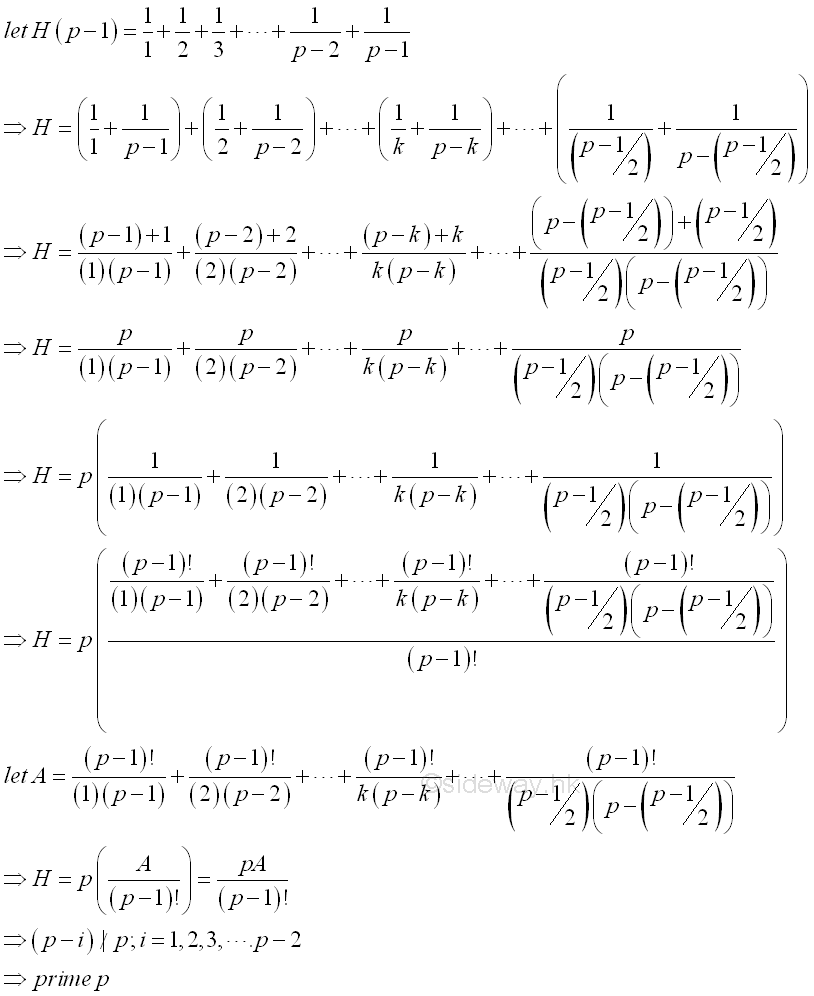
Let Ak=(p-1)!/(k(p-k)), then (k(p-k))Ak=(p-1)!. By Wilson's Theorem, (k(p-k))Ak≡(p-1)!≡-1 (mod p). Imply (pkAk-k2Ak)≡-k2Ak≡-1 (mod p). Imply k2Ak≡1 (mod p). Therefore Ak≡(p-1)!/(k(p-k))≡(k2)-1 (mod p). As k≢0 (mod p), Ak≡(p-1)!/(k(p-k))≡(k2)-1≡(k-1)2 (mod p). Imply
A≡(12)-1+(22)-1+...+(k2)-1+...+(((p-1)/2)2)-1≡(1-1)2+(2-1)2+...+(k-1)2+...+(((p-1)/2)-1)2 (mod p)
Since k2≡(-k)2
and (-k-1)≡-(k)-1 (mod p).
Therefore A+A which is equal to
(1-1)2+(2-1)2+...+(k-1)2+...+(((p-1)/2)-1)2+(1-1)2+(2-1)2+...+(k-1)2+...+(((p-1)/2)-1)2 (mod p)
can be expressed as 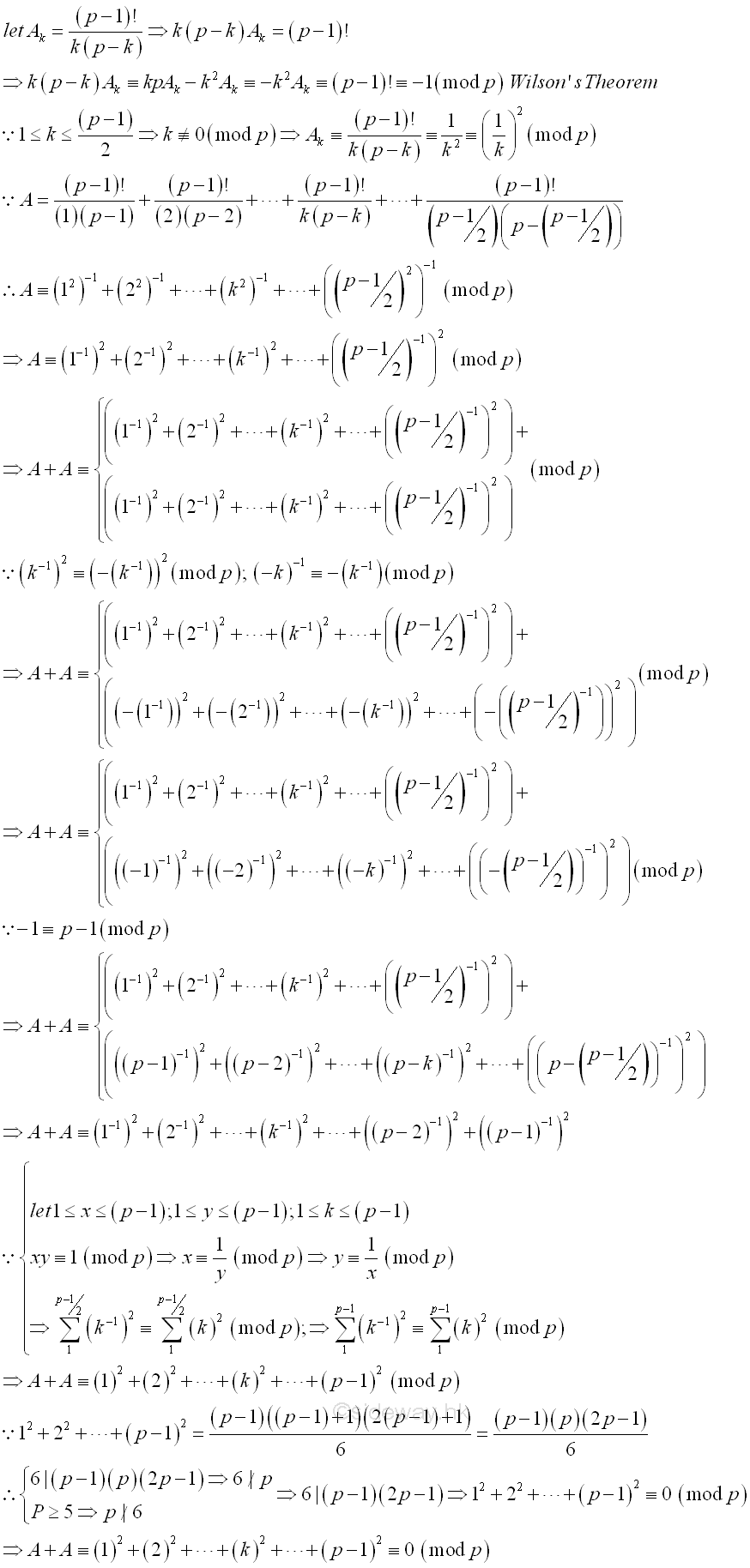
Thus 2A≡0 (mod p). Since 2∤p, imply p|A, that is A≡0 (mod p). Therefore A can be expressed as pB where B is an integer and substitute into H, that is H(p-1)≡pA/(p-1)!≡p2B/(p-1)! (mod p). As none of the factors in the denominator of H(p-1) can divide p, p2 must divide the numerator of H(p-1)=1⁄1+1⁄2+1⁄3+...+1⁄p-2+1⁄p-1. Since p divides 2A , 2A=1⁄12+1⁄22+1⁄32+...+1⁄(p-1)2 , 6 does not divide p and as p greater or equal to 5, p does not divide 6 also. Imply p divides the numerator of 1⁄12+1⁄22+1⁄32+...+1⁄(p-1)2 . 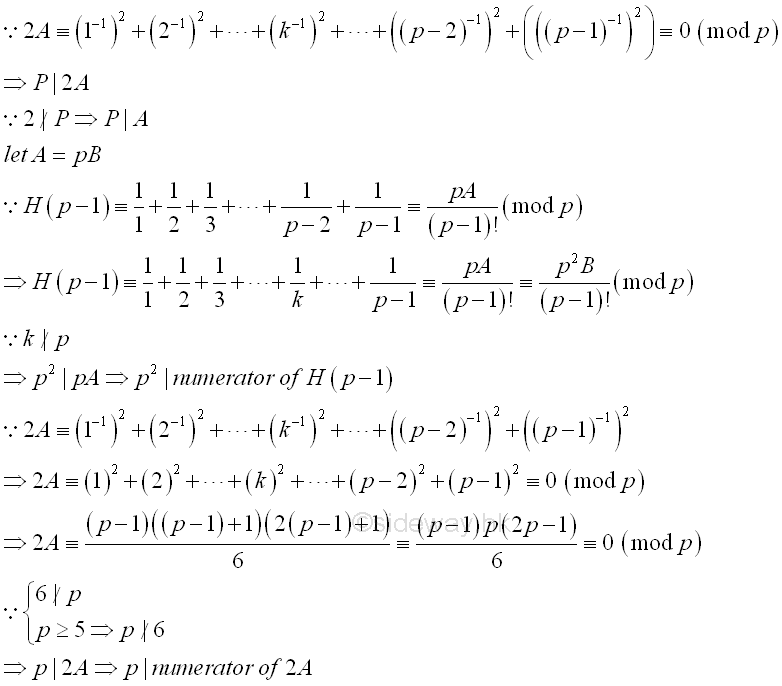
Based on these properties, wolstenholme generalizes to the property to the special case of n-1 combinations of 2n-1 is equivalent to 1 when divided by n3. The series 1+1⁄2+1⁄3+...+1⁄n-1 can be obtained from a combinatorial series. 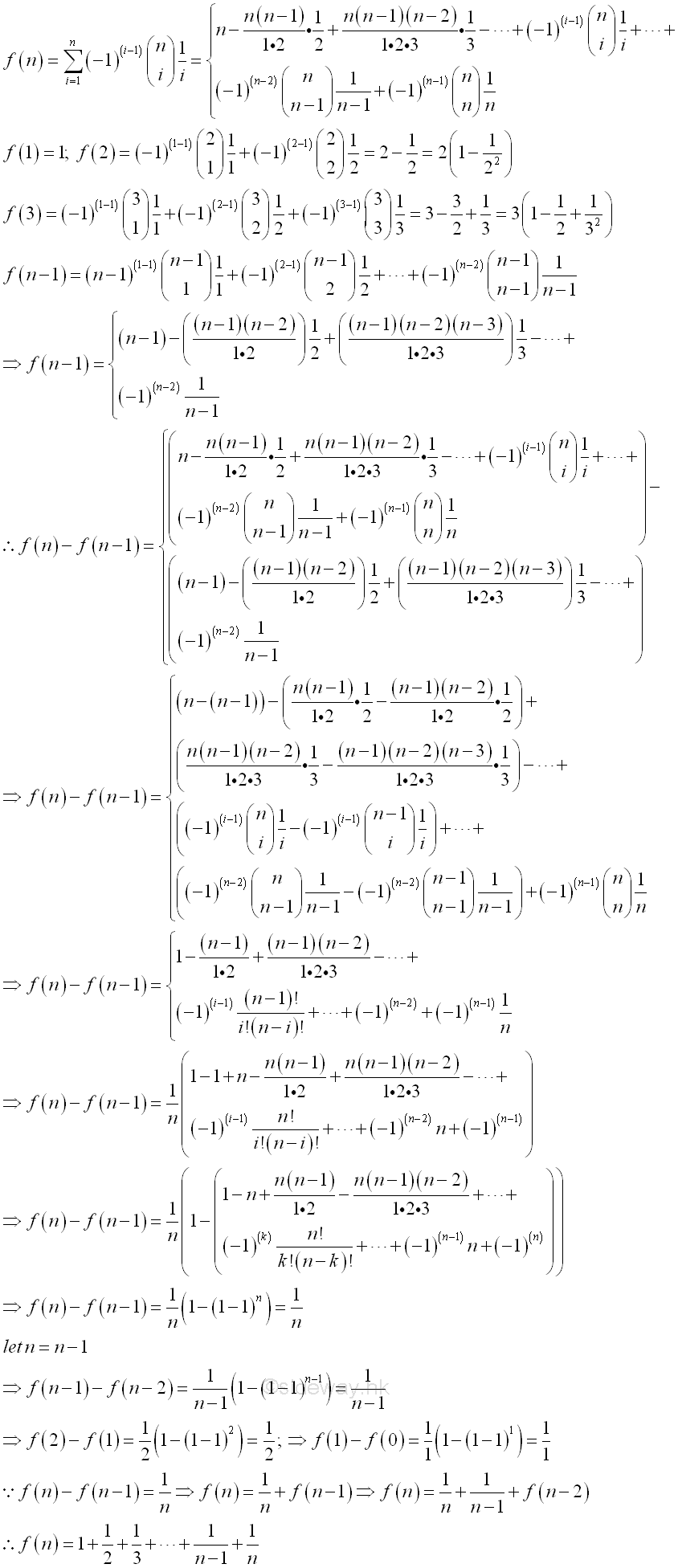
If n is a prime greater than 2, then n is odd and the sign of coefficient of f(n-1) can be fixed. Therefore f(n-1) can be expressed as. 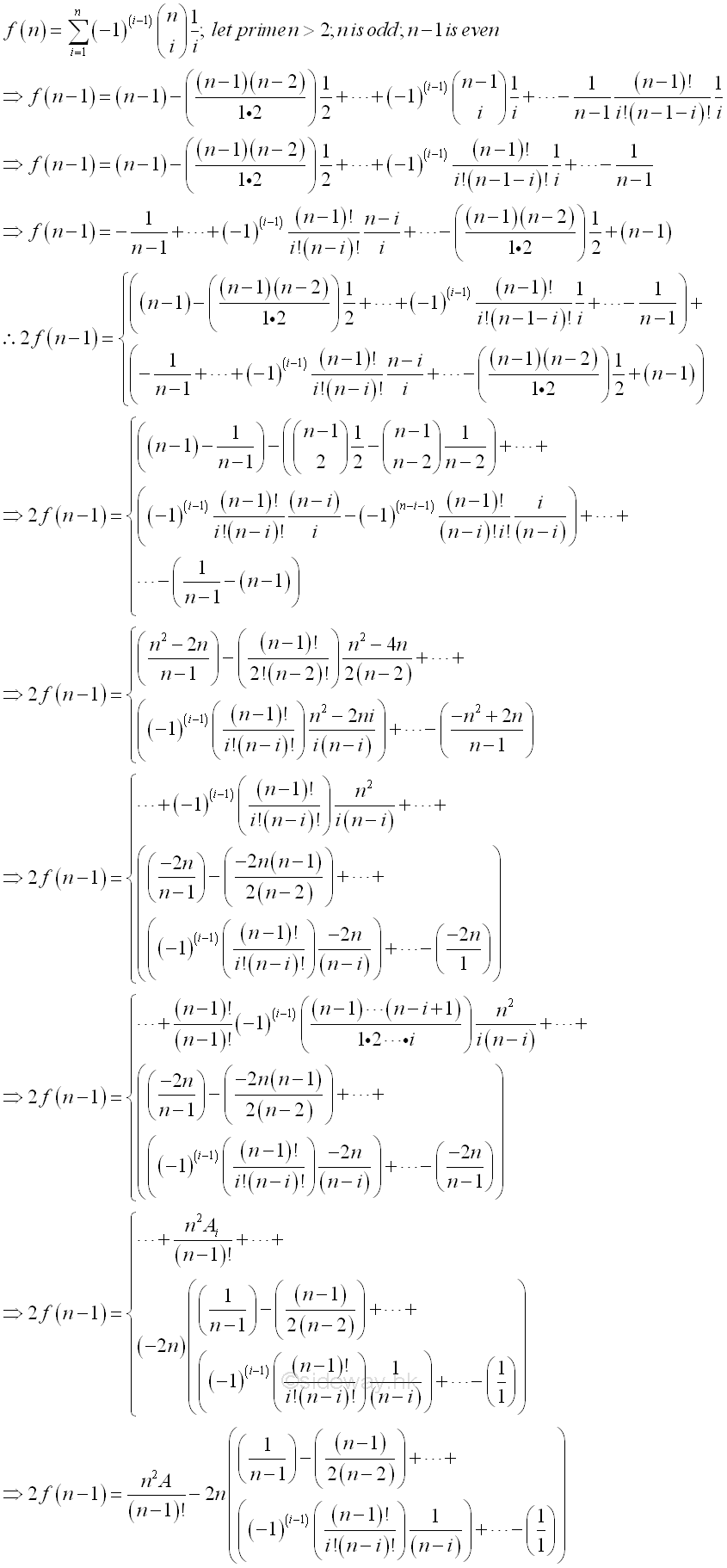
Part of the multiple of n2 of 2f(n-1) is represented by A. Further, part of the multiple of n of remaining 2f(n-1) can also be represented by B as following. 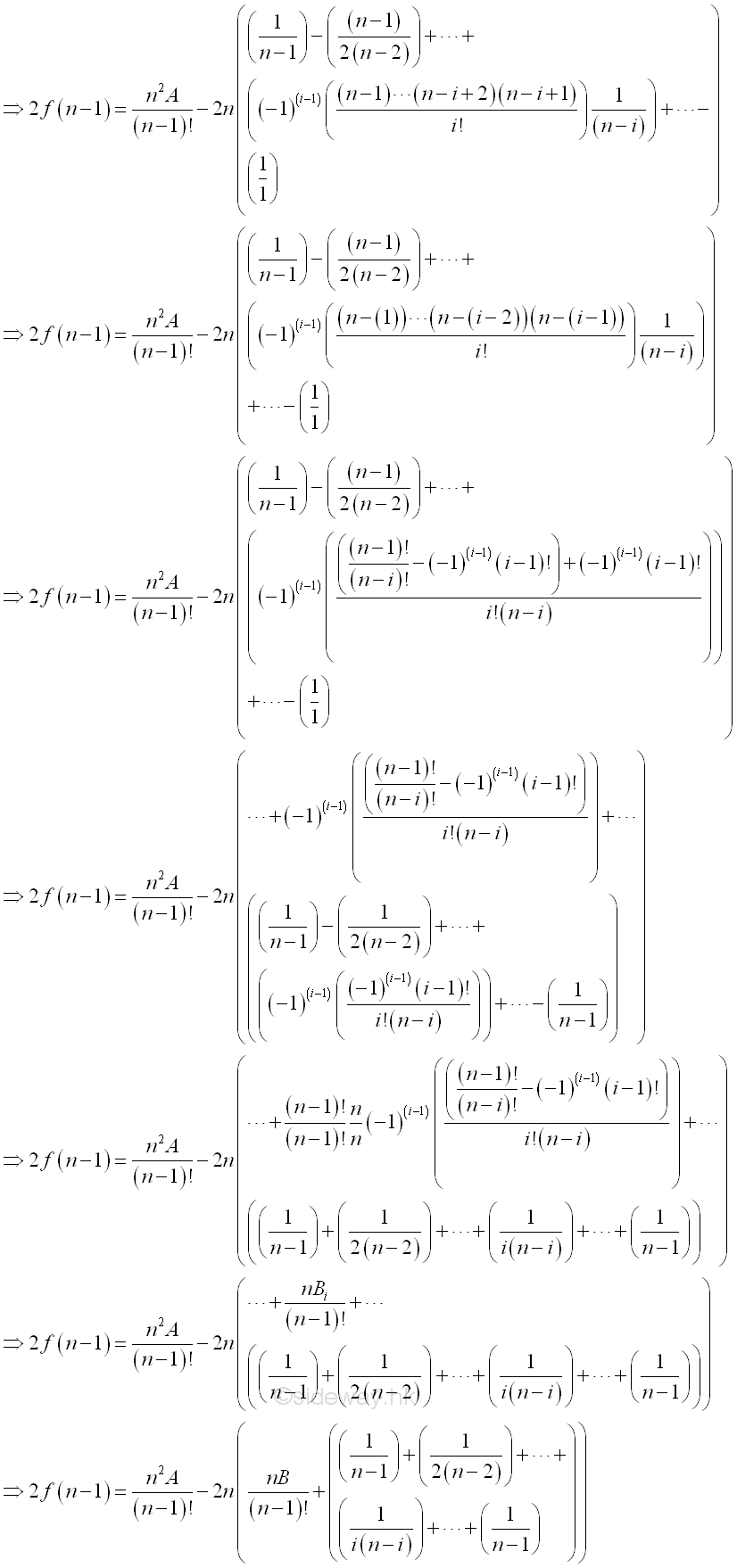
The part of the multiple of n can also be expressed in term of n2 also. Besides the remaining part can also be expressed in term of f(n-1). Imply. 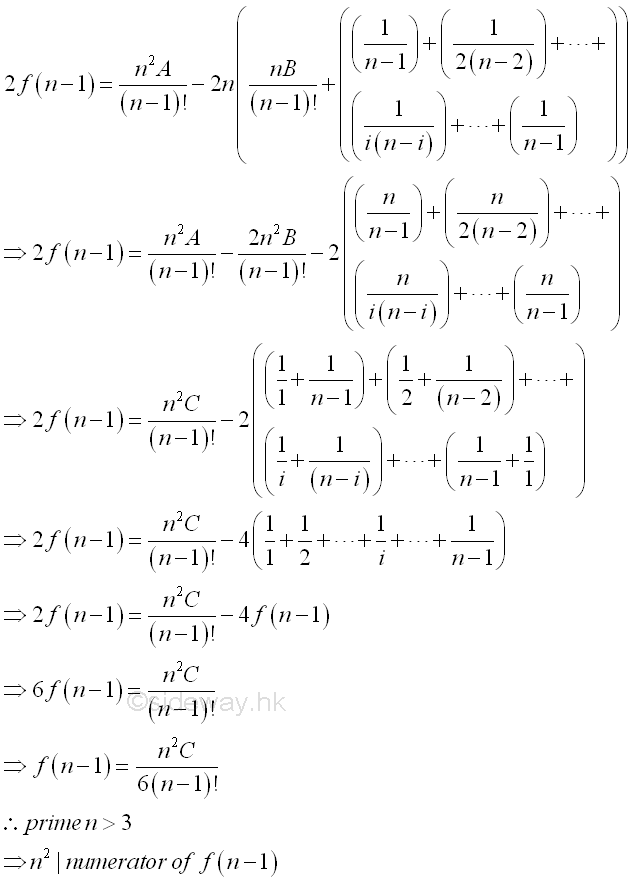
Therefore, if prime n greater than 3, n2 divides numerator of f(n-1). Similarly the series 1+1⁄22+1⁄32+...+1⁄(n-1)2 can also be obtained from f(n-1). Imply. 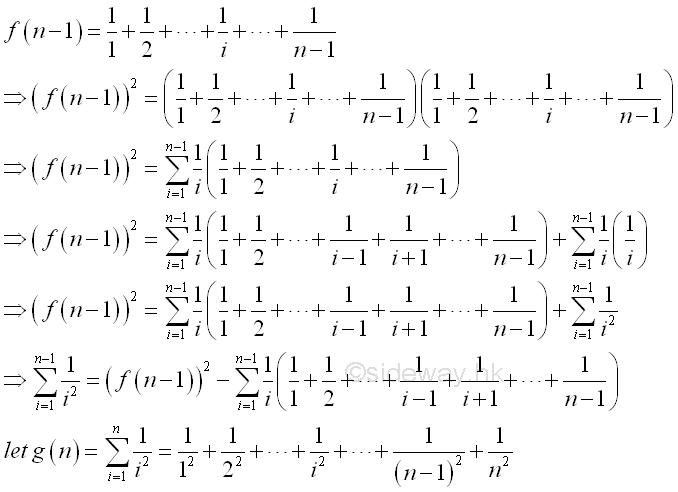
Similarly the series can be expressed in term of f(n-1) also. Imply. 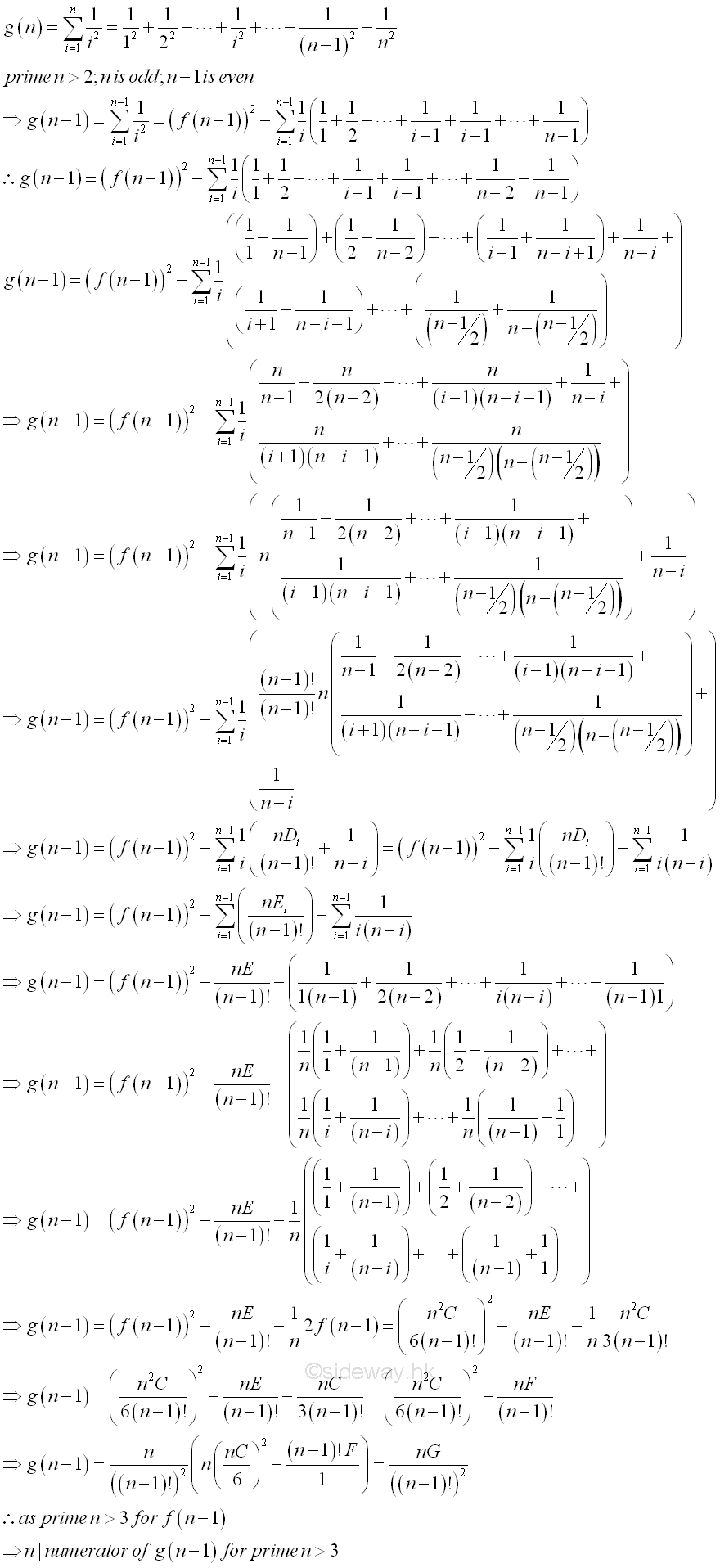
Therefore, as limited by f(n-1), if prime n greater than 3, n2 divides numerator of g(n-1). Based on these properties, the combination of 2n-1 takes n-1 can also be expressed in terms of f(n-1). Imply. 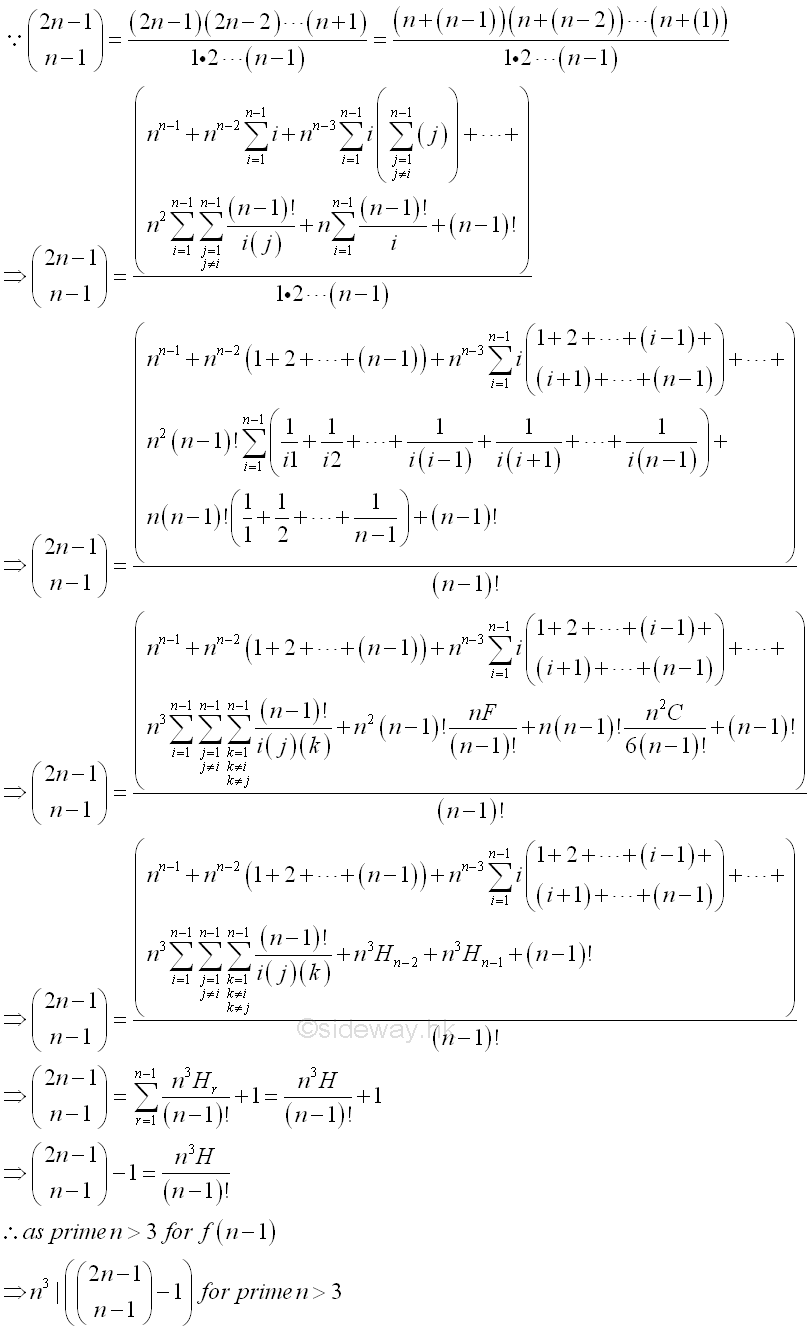
Therefore, as limited by f(n-1), if prime n greater than 3, n3 divides the combination of 2n-1 takes n-1 minus 1. |
Sideway BICK Blog 19/04 |
||||||||||||||||||||||||||||||||||||||||||||||||||||||||||||||||||||||||||||||||||||||||||||||||||||||||||||||||||||||||||||||

